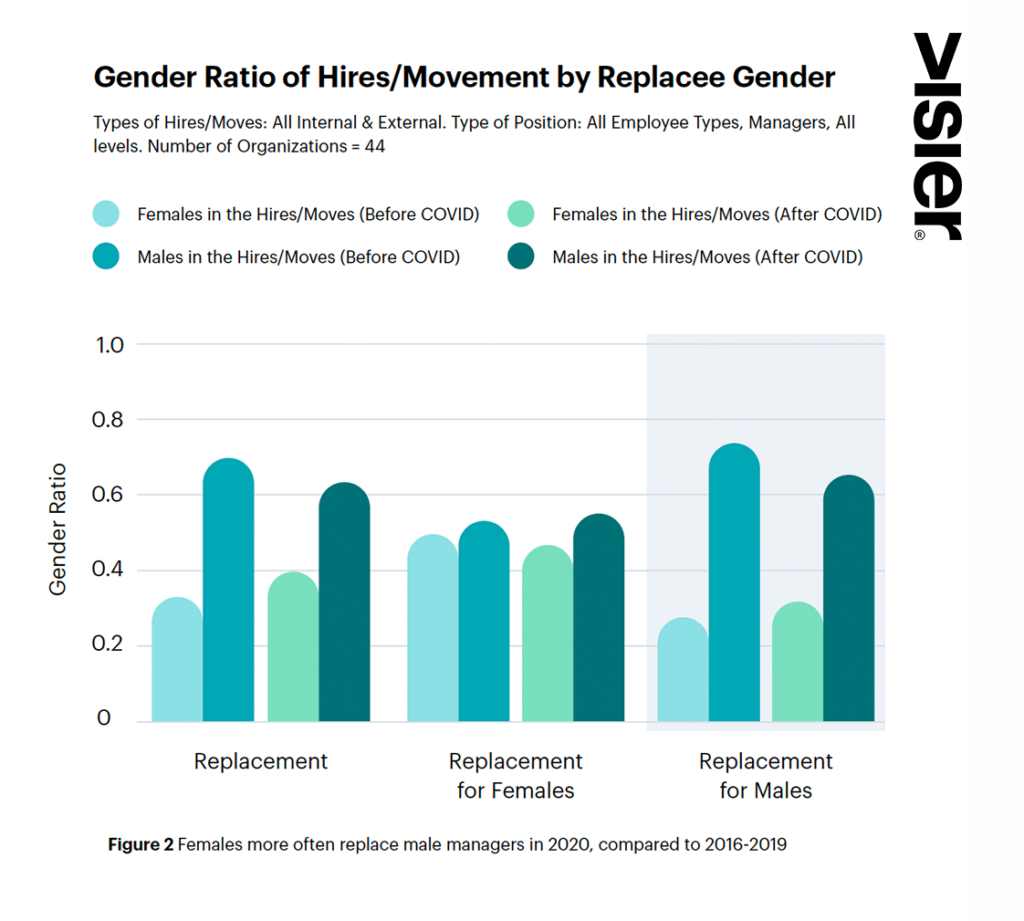New Data on Women Breaking the Glass Ceiling
Findings from the new Visier Insights Report: Cracks in the Glass Ceiling show two contrasting realities on women's advancement in the workplace. Read on.

Women represent half of the world’s population and half its potential. Empowering women spurs economic growth, productivity, innovation, and trust–recent examples include the newly appointed female Citi CEO and a female CEO in Washington state leading her company to an IPO.
In spite of the outperformance of female-led organizations, according to McKinsey in 2018, progress on gender equality has stalled. While organizations report they are committed to gender diversity, that commitment has not translated into progress for most. A glass ceiling still exists on women’s advancement.
What is the glass ceiling and why does it exist?
40 years ago, the phrase “glass ceiling” was coined by management consultant, Marilyn Loden, to describe the invisible barriers that hold women back from career advancement.
“I am referring to the biases that assume men are “born leaders”,” explained Loden in a piece she wrote for BBC, “that working mothers are not committed to their careers, that women are too emotional, that sexual harassment is not a problem, and that there is no room on the executive floor for people who speak softly, have a high degree of emotional intelligence and favour participative leadership over autocratic management.”
As Loden wrote, these blockers tend to be unfair and exclusionary practices that keep women from rising in the ranks; instead, tending to favor their male counterparts for promotions.
“We need only remove the blinkers to appreciate and leverage all that [women] have to offer,” she adds.
New statistics on the glass ceiling reveal some progress
Findings from the new Visier InsightsTM Report: Cracks in the Glass Ceiling show two contrasting realities at organizations today:
In upper management, women are much less likely to succeed a male than men are to succeed a female

In lower management, females are replacing males at higher rates

The report focused on the movement of men and women into management roles at Visier customer organizations. For analyzing the executive level, we had 19 organizations with movement from external hiring, internal hiring, and promotions. When analyzing all manager roles (all levels), we had 44 organizations. These 19 to 44 organizations employed 257,860 to 463,699 employees.
Though it is discouraging to see that men usually fill vacant senior management roles previously held by either a man or woman, the second finding shows exciting progress towards gender equality among lower-level managers. This succession is a positive sign that women are poised to crack the glass ceiling that has so long held them back from leadership positions.
But there is still work to do: True progress means women shouldn’t only be replacing other women in leadership roles–we need to see an increase in women replacing males in all levels of management and specifically senior roles. A key way to achieve this is through the use of people data and analytics, which have been proven to improve female leadership representation at organizations.
How to break the glass ceiling: 8 data-driven steps to more gender equality
An earlier report from Visier showed that after using people analytics for two years, organizations improved their female leadership ratio to males by 11.5% and improved their retention of female leaders by 70%. This report found that analytics and dedication to proactive diversity and inclusion programs helped increase female leadership representation and retention, improve diversity, and address inclusion inequity in all business operations.
Improving female equality requires assessing the starting point, benchmarking, establishing goals, and creating a roadmap with milestones and clear accountability. Through all these steps, data is critical to avoid guessing and make a case for change:
Start with the basics. What is the representation of females across the organization? What is it for leadership levels and lower management levels? What is the overall female-to-male ratio across the organization? Go one step further and measure this for both white and diverse groups. Intersectionality also matters. From all of this, you can set your baseline to understand where you are starting from as a critical component to improving female representation and moving towards equality.
Get context by comparing your representation to benchmarks. People analytics platforms like Visier provide multiple benchmarks, including EEOC data that shows how you compare against the market of labor you’re hiring from. This comparison may also show unknown areas of bias within your organization.
Identify root causes, then identify areas of bias. The lifecycle of an employee can be quite complex and ultimately, you will want to get quite granular to impact activities across the employee lifecycle. Dig deeper into these numbers to identify what biases exist in your processes that are preventing gender equality in all stages from hire to retire.
Focus on bottlenecks. Mercer suggests looking for the presence of bottlenecks where rates of advancement into a higher level shrink precipitously, affecting one gender such as where promotion rates for women fall below those for men.
Watch for demographic cuts where numbers are off. Instead of generalizing the need to improve across the organization, be precise about what the problems are and where they lie. This enables HR to be more efficient about their support and challenge leaders with precision.
Have data-driven career conversations. Then map these back to strategic workforce planning and career planning activities to identify where high potential women need to build skills to meet both organizational and individual needs.
Share insights. Create change by sharing data, ideally publicly, to create more accountability (here’s an example of one organization’s public statement). But you can also start with internally sharing data to give visibility and make equality improvement a shared problem before taking insights public.
Review changes over time. To see whether your strategies worked, track your historical data and keep an eye on downward trends that may need attention. Drill down deeper into the data by location, department, or job. Your overall metrics may actually be good, but when you look by any other dimension you may find pockets of problems where equality is lacking.
Gender equality is everyone’s responsibility
What contributes to improving female equality in management? CEO commitment to leading a female equality improvement agenda, a comprehensive data-supported strategy (including monitoring and publicizing the status of your efforts), specific attention on removing bias from all aspects of the employee lifecycle, and individuals stepping up to take personal responsibility for advancement. These are all important actions needed to see more women in leadership roles.
Data plays a powerful role in improving gender equality. Ideally, it should be accessible for everyone in the organization to review and speak from. Change happens when we all take responsibility to accomplish what we want.


